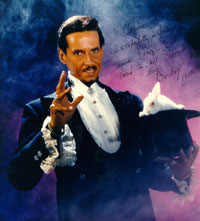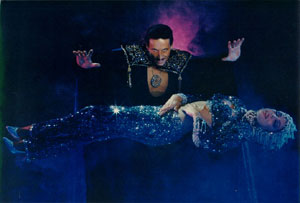Eugene Burger
Originally published in Genii Magazine, November, 1996
 This November marks the fourth anniversary of Barclay Shaw’s death. I first saw Barclay in a little bar in Chicago in 1964. A friend had called to invite me. I replied, “Who is Barclay Shaw?” I was told, “He is probably the greatest puppeteer alive today.” That evening, Barclay gave a special one night only performance for some charitable cause. He performed standing on the bar with Toto the Clown and Clara Cluck and even Mr. Magoo, a marionette that was later stolen from his car and never rebuilt. Barclay was absolutely wonderful.
This November marks the fourth anniversary of Barclay Shaw’s death. I first saw Barclay in a little bar in Chicago in 1964. A friend had called to invite me. I replied, “Who is Barclay Shaw?” I was told, “He is probably the greatest puppeteer alive today.” That evening, Barclay gave a special one night only performance for some charitable cause. He performed standing on the bar with Toto the Clown and Clara Cluck and even Mr. Magoo, a marionette that was later stolen from his car and never rebuilt. Barclay was absolutely wonderful.
The next time I saw him was in March, 1974, when he performed at Chicago’s Blue Max nightclub. Another friend, also a puppeteer and a real fan of Barclay’s, had mentioned that Barclay was appearing. This time I suggested we attend.
I didn’t see him again until 1985, when we were assigned to the same dinner table on the MagiCruise. We quickly became friends. I visited him many times in Las Vegas when he was appearing in Splash at the Riviera Hotel. I’m sure I saw the show a dozen times. After the show, we would usually get something to eat and then return to Barclay’s. Because the drapes in his home were completely opaque, we would sit up discussing magic all night — never realizing it had gotten light outside! We would go to sleep and when I awoke the next afternoon, Barclay would invariably be up and working on some creation.
Even at the peak of his performing power, when he was starring in Las Vegas in the late 1980s and early 1990s, Barclay Shaw was probably unknown to most magicians. After I dedicated my book The Experience of Magic to him in 1989, where I talked about his astonishing presentation of the Levitation, several dozen magicians asked me who he was.
 “THE WORLD’S GREATEST EXPONENT IN THE ART OF MARIONETTES AND MIRACLES”
“THE WORLD’S GREATEST EXPONENT IN THE ART OF MARIONETTES AND MIRACLES”
Barclay Shaw was born in England on July 4, 1931. By the age of five he was already a child actor for a major film studio where his father was the musical director. He once said, “I was on movie sets as early as I can remember. I made friends with all the technicians, a great experience. Those guys just love a child who really wants to learn. I picked up plenty too.”
Three years later Barclay’s family moved to New York City. It was here on a shopping trip that his young eyes were first captivated by a little clown marionette bobbing up and down on an electric control in Macy’s department store window. The marionette was purchased and Barclay set about learning its secrets.
A year after that the family moved to the island of Jamaica in the West Indies. “Moving,” Barclay said, “was our middle name. I left the little clown with my schoolmates. I had learned all I could from it. It was, after all, only a toy, and the kids had fallen in love with it.”
In Jamaica, Barclay’s lifelong love of magic was awakened when he attended the performance of a visiting magic company headed by a female illusionist, Cleopatra. Barclay saw the show many times during its six month run. Soon the teenager was performing himself with a two-hour show of magic and puppets.
Barclay returned to New York and spent two years honing his craft on the famed Catskill Mountain resort circuit, appearing with Danny Kaye, Nat “King” Cole, Sarah Vaughn, Sophie Tucker, Cab Calloway and Duke Ellington. During these years, Barclay’s act featured two marionettes. First, Toto the Clown, which Bob Hope would later proclaim “a classic!” Barclay’s consummate skill at making little Toto come alive was unbelievable, as was the relationship which developed between puppet and puppeteer. Toto would blow up a balloon which lifted him off the ground. It was a magical moment that abruptly changed when Barclay suddenly stepped on the balloon and broke it — a startling moment that absolutely stunned the audience! The little clown’s reaction to the broken balloon and the ensuing interaction between Toto and Barclay created an act that, once seen, was never forgotten.
Barclay’s other marionette was Clara Cluck, “The World’s Foulest Chicken.” Clara became another classic. Witty, irreverent and naughty, she we definitely a show stopper. At one memorable point in the act, Clara would lay a large egg which cracked open, revealing a baby duck! “Let me think…” Clara would say. “I must have been really wiped out. You never forget a duck — they’re greasy as hell! I don’t know what I’m going to tell my husband. He’s a horse! Our church is a little more liberal…”
The next ten years were spent in Miami Beach where Barclay performed in every major hotel showroom. He was then signed by the producers of Holiday on Ice, the first time that a show of this type had ever booked a marionette act. Barclay was with the show for two years and could have stayed longer, but he was getting tired of traveling. He moved to Hollywood and worked every major nightspot in Southern California. During these years he signed with Paramount Pictures to head their animation department. He said, “I thought it was going to be great fun, but as it turned out, it was a great bore, and I sat around doing nothing most of the time.”
George Liberace, the brother of the famous pianist, had an office in the sane building, and he signed Barclay to his newly-formed management agency. It was George Liberace who introduced Barclay to Las Vegas. There, Barclay debuted another handcrafted puppet a life-size marionette of Liberace at the piano.
Barclay moved back to the Midwest in 1964, and became a hit act throughout the area. Following an engagement at the Crazy Horse in Paris, Barclay returned to Las Vegas, appearing in the starring spot in the show at the Golden Nugget.
In 1978 he began two years touring with the Liberace Show as the special guest artist. The tour was capped by a Royal Command Performance for Prince Rainier and Princess Grace in Monaco and then a sell-out four week success at the London Palladium.

Barclay returned to Las Vegas in April, 1980 to begin a five-year run — without a night off — as the star of the famed Folies Bergere at the Tropicana Hotel. It was during these years that his good friends Marvyn and Carol Roy urged Barclay to put some of’ his magical illusions into his act. Barclay said, “I believe that magic is an addiction, and you have to be a masochist. It involves countless hours of planning, building. I’ve always built everything I use on stage myself… Then there are countless hours of meticulous rehearsals. It’s a hell of a lot of work and one has to love it!”
(In 1982 a young magician named Lance Burton joined the Folies show, and for some time the Tropicana was in the unique position of having two of the world’s finest magicians in the same show.)
It was during the years in the Folies that Barclay perfected his famed levitation. He said, “I’ve always wanted to do something different with that one… If you are floating, parts of your body move differently from the rest — an arm might start to float higher than the leg, and so forth. You certainly would not be stiff like a board! I am the first illusionist to have the girl moving in the air, a not-so-easy task far her. And I am also the first to enclose the floating lady completely in a glass box! It really drives them wild, and I think one of the kicks that we get out of performing magic is the look of incredulity on the audience’s faces.” In 1983, outside in his backyard in Las Vegas, Barclay performed his levitation at the edge of his swimming pool, in broad daylight, for the popular television show That’s Incredible. And it was.
Barclay left the Folies in December, 1984. He began a tour of major hotels in the Caribbean until January, 1986, when he was signed to headline the lavish revue show Starz at the new multimillion dollar Conrad International Hotel m Queensland, Australia. He was held over twice; the hotel wanted him to stay even longer, but Barclay had a commitment to return to Las Vegas.
In late 1986, Barclay opened as the guest star of Splash at the Riviera Hotel. That elaborate production included on stage waterfalls and fountains, an underwater ballet in a 20,000-gallon tank, and blaring motorcycles doing loop-the-loops in a giant steel sphere. Barclay more than held his own.
He remained several years, and then returned to Australia. In 1990 he came back to Splash where he stayed for several more years. After finally leaving the Riviera show Barclay did television spots in Europe and in South America. He then began planning his own show. He decided that he would call it Barclay Shaw’s Circus of Illusion.
Early in 1991 he called me and asked if ‘I would help him lay out this “dream show” on paper. He began sending me notes and together we began putting ideas on paper; our aim was to produce a written description of the show that he could present to potential backers. Working with Barclay was, for me, a great delight because he was a remarkable talent: Every tune we talked: I felt I learned something new.
